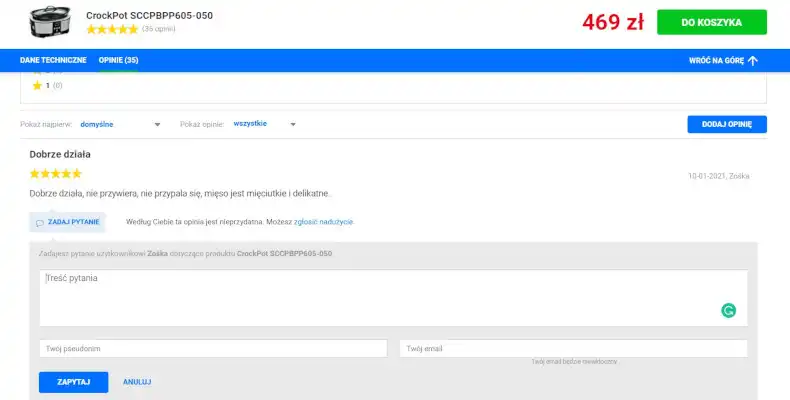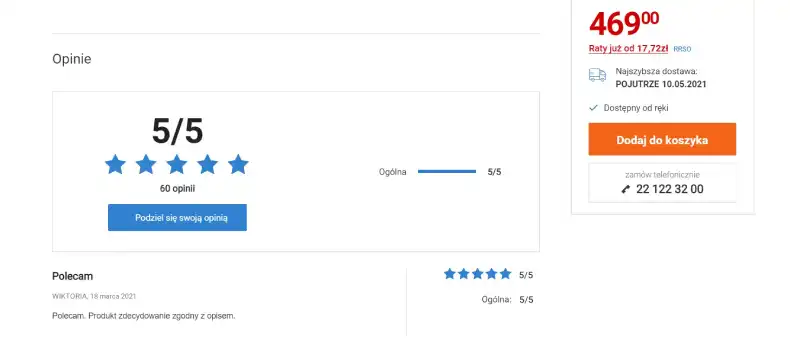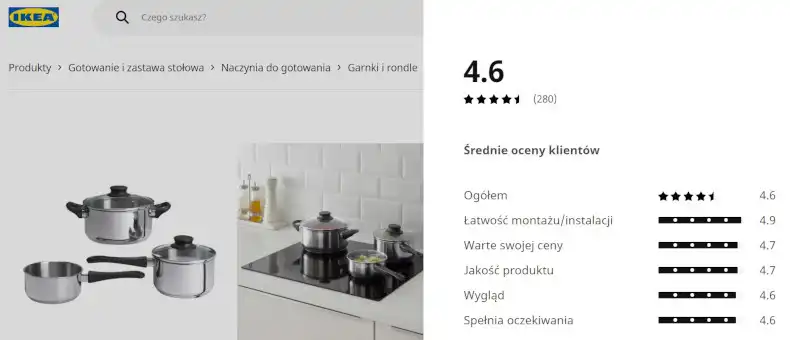Stars, thumbs up, emojis, clapping hands, and probably a few other symbols and icons I can't remember now make up the universe of Rating Systems. What are they? They're ways to express emotions, experiences, assessments, thoughts, advice, comments, and warnings.
They're a tool, a function commonly used in online stores. We can also find them on blogs, under posts, in mobile applications, and virtually everywhere.
Their role in shaping a positive user experience of an online store can hardly be overestimated. Moreover, Rating Systems have become the norm in E-Commerce.
Evaluating an online store purchase has always been important in building credibility and trust.
So, let's look at how to design a Rating System in an online store.
The most popular types of rating systems in E-Commerce
The human tendency to make assessments finds fertile ground in E-Commerce. We like to evaluate, express opinions, share, and learn about them. We like to influence other people's choices. Express our satisfaction (rarely) and our dissatisfaction (more often).

Opinions in online stores are crucial information on the quality of a product and the way the online store works. It's also information on how other people perceive it.
In particular, we value and consider essential the evaluations of people who are in some kind of relationship (e.g., acquaintance) with us.
We pay attention to the opinions of people who differ slightly from us regarding sociodemographic variables (e.g., gender, age).
Rating systems are a reference point. They provide information and are a meaningful message that is:
- Emotional (expresses emotions)
- Rational (expresses opinions and beliefs)
- Socially important (allows customers to satisfy the need of being needed, significant as well as the need to be safe and in control).
We can find at least a few types of ranking systems in a modern online store.

According to a data criterion, we can distinguish the following:
- Quality systems
- Quantity systems
- Mixed systems — a combination of the previous two.
If we look at them from the perspective of the complexity criterion, a way of expressing an evaluation, we can distinguish:
- Passive (simple, black and white division "I like/I dislike," "I enjoy it/I don't enjoy it," "I recommend it/I don't recommend it")
- Scalable (nuance the attitude toward product, offer)
- Based on the selection of ready-made answers to questions
- Based on the free and open evaluation, without directing the scope, the way it is expressed
- Mixed — various configurations of the above types.
In online stores, the so-called star systems are probably the most popular form (usually with a 5-star range). However, usually, stores offer ratings not only through stars but also by providing an ability to expand on them.
For example, with close-ended questions. Or the option to evaluate the opinion of other online store customers using a binary indication of its usefulness, relevance, and reliability.
Star ratings became popular because customers can determine their attitude toward a product, store, or offer in a simple, straightforward, and understandable way.
The 5-star scale is broad enough to express the complexity and, simultaneously, narrow enough not to create unnecessary dilemmas.
As a well-founded convention, it's helpful for yet another reason. Online store customers understand its meaning perfectly well. It's comprehensible to them (allows them to estimate the risk and predict the result of the purchase).
In the mixed variant, it provides quantitative and qualitative knowledge. Often presented in the form of a graphical breakdown of the assessments made.
We mentioned above the close-ended questions that are becoming increasingly popular recently. The advantage of close-ended questions is the convenience and direction of the evaluation, indicating its most important dimensions. Customers can express their attitude in an easy, quick, and, above all, cognitively unburdensome way.
But this has its price. Close-ended question block expressing spontaneous reactions that are individual and in line with actual preferences, feelings, and assessments. They force the user, more or less, to adapt to a pattern.
Their use should be carefully thought through and adapted to the goal we want to achieve with rating systems.

Of all, the binary method is the simplest yet most clumsy and unreliable. It requires a straightforward attitude that can be rarely seen in reality.
Extreme reviews (complete satisfaction/complete dissatisfaction) are rare. In most cases, we are dealing with averaged assessments.
Hence, using the binary method to evaluate opinions on the meta-level is recommended, indicating the attitude not toward a product, offer, or how a store works but toward the assessments of other evaluations.
Customers' opinions matter. Psychological foundations of rating systems
Actually, we should start with questions: Why do we need rating systems at all? Why do we base our purchasing decision on what we read at the bottom of the product page, category page, home page, and section with top-rated products?

Are we that dependent? Are positive opinions essential to us to make a decision?
Well, there are at least a few reasons for that. Here are some of them.
We need reviews, opinions, and ratings because when buying in an online store, we have to deal with the following:
- Deficit of experiences and information (we can't see the product, check and see its use)
- Higher risk (e.g., wrong purchase, fraud)
- Need to see "the other side of the coin" — stores rarely or actually never highlight the flaws of their products, and customers definitely want to focus on them
- Ability to see a broader perspective
- Option to predict and estimate the risk
- Limited trust in the store and much more confidence in the opinions of other customers.
Naturally, we live in a world of fake reviews that significantly reduce the trust and credibility of a store and other customers.
Customers are aware of this, but if an online store consistently cares about the quality of product reviews, allows critical comments, and responds to them, it definitely increases the sense of authenticity, truthfulness, and usefulness of such reviews and opinions.
Here, we want to recommend a great article, "You Just Got Attacked By Fake 1-Star Reviews. Now What?." As it turns out, the problem is much more complex, but it's a topic for a separate article.
Furthermore, reviews, assessments, and opinions about products fulfill the role of social proof, which strongly affects our attitude toward an offer. Their credibility is much higher than that of advertisements.
What's more, they're also evidence that can't be underestimated.
They suggest and prove that the online store:
- Works
- Has customers
- Is popular.
By analogy, rating systems can be compared to a line that is lined up at the entrance to a stationary store. Naturally, such an image arouses our curiosity. It evokes the need to discover what we can gain and miss out on.
But it's not just about our tendency to mimic others. Nor is it just about our tendency to conformism.
It's about the economization of cognitive processes. Reviews are especially important in stores where the assortment in a given category exceeds hundreds or thousands of similar products. None of us really wants to browse them for hours.
Sifting through them, even with the help of a search engine, filtering and sorting is simply very costly. It's about cognitive effort, time, energy, and uncertainty.
Mimicing others is convenient. It definitely simplifies actions, orientation, and making decisions. In an increasingly complex social, commercial reality, it's an invaluable tool.
Using a rating system helps select and become confident in the choice made. The store's activity in this dimension also has its importance.

A potential customer, when seeing the reaction of the store's staff to a negative comment or problem (especially if they offer a solution), gains confidence that the store takes responsibility and is friendly, helpful, and sensitive to problems.
Why is it worth using rating systems?
Let's put it bluntly: Rating systems are free research materials. They're a source of feedback (e.g., about products) that can be analyzed from many angles.
For instance, in terms of the following:
- Level of satisfaction regarding the scope of assortment, quality of products, quality of service, attractiveness of the offer
- Structure, customer segments
- Perception and reaction to the brand — its missions and values
- Position of the store in comparison to the competition.
As well as:
- Optimization of user experience (UX) and customer experience (CX)
- Optimization of the path to purchase design
- Development of a store and making strategic decisions
- Introducing new products
- Customers' commitment.
Sofia Quintero, the author of the article "Which Rating System Is Best for Your Users?" from among the abovementioned ones, considers three to be the most important.
Namely:
- Algorithmic personalization
- Aggregation of decision-making
- Identifying value.
Ranking systems allow us to tailor and personalize an offer more precisely. Automatization and algorithmization of these processes enable us to more accurately and satisfactorily fulfill customers' expectations. For many stores, it will be a cardinal argument.

Aggregated ratings expressed numerically in the form of averages, often expressed through charts, visual representations of proportions are an effective tool for supporting the purchase decision.
As Sofia Quintero notes, aggregated ratings are particularly useful when buying products that require more extended consideration. So it shouldn't be surprising that rating systems are used by online stores which offer luxurious goods.
Rating systems allow users to express preferences, indicate a hierarchy of importance, and suggest solutions.
While on the problem of the distribution of ratings, it's worth bearing in mind the results of a study by the Baymard Institute, which was presented in the article "UX Research: 5 Requirements for the 'Ratings Distribution Summary' on the Product Page (65% Get it Wrong)".
According to it, users need rating distribution to form an opinion. Hence, it's crucial to offer it in a graphical form as bar charts, for example.
No matter how telling, dry data won't have the same impact as its visual representation. Moreover, as the author astutely notes, the mere average of ratings and their number is insufficient, as it can "distort reality." All the more so that stores don't always use weighted averages (that are less prone to extreme ratings).

The distribution of ratings indicates precisely which assessments partially made up the average, and they can be extremely different. Their interpretation can also differ. When presenting the distribution, it's worth offering filters. With that said, filters shouldn't be combined together.
The distribution of ratings allows you to see the following:
- Number of ratings
- Proportions
- Trends.
Reviews and opinions about a product
It's not a special discovery that the popularity of reading reviews exceeds the popularity of writing reviews. Unfortunately, it creates situations in which biased opinions appear or dominate — often written with bad intentions and contrary to the facts.
As customers, we tend to express negative opinions. Positive product reviews are less likely to motivate people to express them on the product page.
From the perspective of the store's customer, it's never obvious whether the product is really that bad or is not good enough for a few righteous people to defend its dignity.
Fortunately, this is not a frequent phenomenon, but it is worth keeping this regularity in mind when moderating reviews and opinions.

Another issue, besides credibility, honesty of opinions is also their length. The problem arises from two extreme tendencies — opinions that are too short (buzzwords that say almost nothing) and too long (lengthy, full of digressions, stories, and unnecessary information).
Both these variants frustrate customers. Hence it's worth:
- Considering using a character limit (the customer's review should be primarily helpful)
- Offering questions regarding the most important aspects (with that said, remember that the review shouldn't be a F.A.Q. section, it should instead bring value regarding quality)
- Allowing the addition of photos that enhance the credibility of the review
- Offering sorting and filtering
- Highlighting and awarding the best, most helpful reviews.
Rating Systems in online stores. Summary
- Rating systems allow customers to express emotions, experiences, assessments, advice, comments, and warnings.
- They're a function commonly used in online stores.
- They're crucial information on the quality of a product and the way the online store works.
- Assessments, opinions, and reviews are significant reference points. They provide important information from the purchasing standpoint.
- In online stores, 5-star rating systems are popular.
- The 5-star scale is broad enough to express the complexity and, simultaneously, narrow enough not to create unnecessary dilemmas.
- Extreme ratings are rare. In most cases, we’re dealing with averaged assessments.
- When buying in online stores, we experience, among others, a deficit of information and face a higher risk.
- Rating systems fulfill the need to "discover the other side of the coin."
- It's a best practice to permit critical opinions and react to them. This increases the sense of their authenticity, truthfulness, and usefulness.
- Reviews, ratings, and opinions are social proof.
- They're essential in stores where the assortment in a given category exceeds hundreds or thousands of similar products.
- Rating systems help gain confidence in the choice made.
- Thanks to them, we can tailor and personalize an offer more precisely.
- They allow users to express preferences, indicate a hierarchy of importance, and suggest solutions.
- Online store customers need the distribution of ratings in the form of bar charts to form an opinion.
- No matter how telling, dry data won't have the same impact as its graphical representation.






